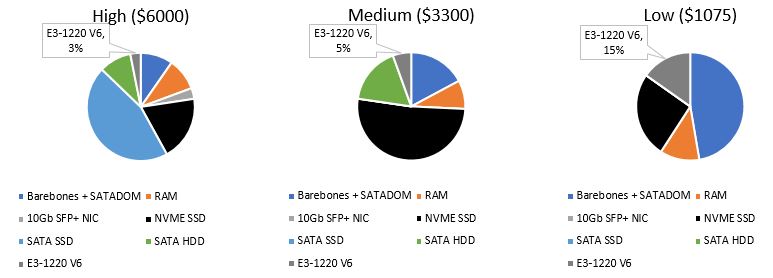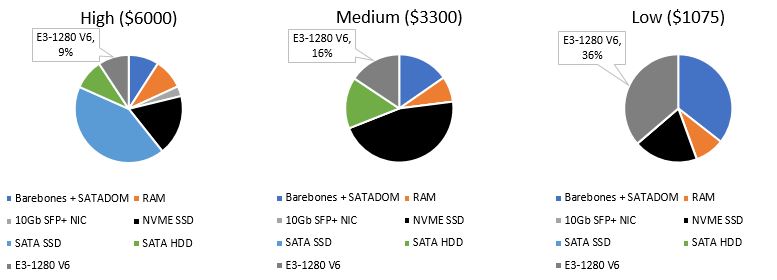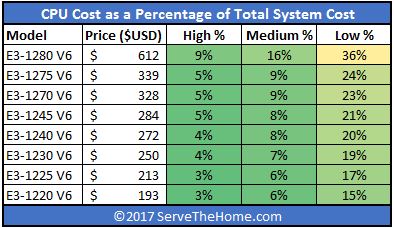Prior to the Intel Xeon E3-1200 V6 series launch yesterday, Intel sent us the relevant information minus pricing details for our launch piece. Today we were able to look up the finalized recommended pricing on Intel’s ARK site. We know there are many STH readers who utilize the Intel Xeon E3-1200 series CPUs, so we wanted to provide a value comparison as we usually do for these new chips. This time, we are introducing a new component: impact to total system hardware costs.
Determining the Best Value Intel Xeon E3-1200 V6 Series Processor
Admittedly, there are a number of factors that go into what is the best value. For example, if you wanted to purely build a small storage server and therefore wanted the I/O of the Intel Xeon E3-1200 V6 series, the Intel Xeon E3-1220 V6 is clearly the best option. Alternatively, if you need an integrated GPU, there are only three options available. For this exercise, we are going to focus on how much you are paying for compute.
With Intel Kaby Lake generation processors, the biggest differences are in the number of cores, threads and clock speeds. Each clock performs about the same amount of work on a core. As a result, we can take the number of cores/ threads doing work, the base frequencies and then multiply to get a raw amount of work. We can then divide that figure by the recommended price and get a metric for performance / price. We have done this for many generations now and received several requests when this was omitted in the V6 launch piece. Here is what the chart looks like for the Intel Xeon E3-1200 V6 series:

One nuance to the above is that the Intel Xeon E3-1230 V6 trounces the E3-122x V6 processors when one looks at threads. Hyper-threading can provide a substantial boost in many workloads, and we often see around a roughly 30% speed-up in the benchmarks we profile. Of course, for some applications, Hyper-threading is detrimental to performance, for others it is more beneficial. We decided to present an adjusted figure adding a 30% performance bump for HT to make this more realistic. Here is what that looks like:

That adjusted figure brings the E3-1220 V6 and E3-1230 V6 much more in-line than the threads * base clock figure. It also moves the E3-1220 V6 ahead of the Intel Xeon E3-1270 V6 in terms of value.
If you do need a GPU, there are only three options to chose from. Here, one will need to closely determine if their application can take advantage of Hyper-threading as that will make a substantial difference with regards to which chip is a better value. Here is a more focused view of the GPU enabled parts with a “5” at the end of their model numbers.

If one does not need a GPU, we suggest purchasing a Xeon E3-12×0 V6 series part with a “0” as the final digit in the model number. Here is what the pure CPU compute chips look like in terms of price.

Again, we see that the Intel Xeon E3-1220 V6 is the best value if one cannot utilize HT. If one can utilize HT, then the Intel Xeon E3-1230 V6 may be the best value.
Total System Hardware Cost Context
Many in the industry spend a lot of time debating small differences in CPU pricing. That is a component, but often a small component in system pricing. Although the Intel Xeon E5 and E7 series are certainly more prone to being a lower percentage of total hardware spend, we wanted to take a look at what CPU pricing costs in the context of systems. Here we will utilize three configurations with a common base system cost and call each high, medium and low. We can then look at the CPU cost in context of overall system cost.
Common Components
We are going to assume two common components a barebones platform for the servers. These can, of course, vary widely but we wanted to set a target with some common features:
The total cost there, as of this writing is around $600.
High Configuration
Here we are going to max-out RAM, add an add-on networking card (necessary given the platform is only 1GbE by default), and add hard drives and SSDs.
- RAM: 64GB DDR4 ECC
- NIC: Intel X520-da2
- NVMe SSD: Intel DC P3520 2TB
- SATA SSD: 4x Intel DC S3610 800GB
- SATA HDD: 2x WD Red 8TB
That is certainly a higher-end system and there is plenty of room to expand.
Medium Configuration
Here we will forego half the RAM, downgrade SSD capacity and remove the higher-speed networking.
- RAM: 32GB DDR4 ECC
- NVMe SSD: 2x Intel 750 1.2TB
- SATA HDD: 2x WD Red 8TB
Low Configuration
On the low-end, we will go with a single SSD and 16GB of RAM.
- RAM: 16GB DDR4 ECC
- NVMe SSD: 1x Intel 750 400GB
Intel Xeon E3-1200 V6 in Total System Hardware Cost Context
First, we wanted to visualize what each of the configurations is priced at as of the Xeon E3-1200 V6 announcement, without processors.

With that information, we can then add the extremes of the lineup, the Xeon E3-1220 V6 and Xeon E3-1280 V6 to see how the overall CPU price impacts total system costs:

Adding an Intel Xeon E3-1220 V6 one can see that the CPU makes up 3%-15% of total system costs. On a lower-end system, the E3-1220 V6 can make up a substantial portion of the total system cost. On our medium and high systems, it makes up less than 5% of total costs.
Turning to the E3-1280 V6 here is what the charts look like:

Here one can see that in each of the configurations the CPU starts to make up a substantial cost when using the top SKU. For our Low-cost system scenario, the CPU is 36% of the total system cost and the largest cost component.
Putting this into additional perspective across the line-up, here is what the CPU costs stack up based on a percentage of our three sample configurations:

The impact of this chart is simple. While the nominal price differential between an Intel Xeon E3-1230 V6 and an Intel Xeon E3-1270 V6 may be $78 or 31%, the impact to a full configuration is often only 1-4% of total system costs.
Final Words
We think the general sweet spot is around the Intel Xeon E3-1240 V6 CPU. It provides Hyper-threading as well as giving access to the overall Intel Xeon E3-1200 V6 platform at a reasonable price. The performance delta between the E3-1280 V6 and the E3-1270 V6 should be relatively minor for an overall increase of almost double, or an impact of 4-13% of total system costs. For those looking at low-cost appliances, the Intel Xeon E3-1220/ E3-1225 V6 CPUs still reign supreme. We looked at the overall hardware costs but there is one more important component to the equation, software license costs. For applications that are licensed on a per-core basis, license costs can easily eclipse hardware costs. For those applications, the Intel Xeon E3-1280 V6 may be worth every penny for the speed bump over lower-end models.




I like the pie charts. Hawt
Very nice article. What’s IMHO most important now is if AMD is going to push also Ryzen to workstation market and validates ECC RAMs there at least on some boards. If this happen, then E3v6 versus Ryzen will be interesting comparison too…
Btw, I also find your maximum configuration a little bit unbalanced. You loaded it with so much storage and fast that I would consider 64GB RAM to be bottleneck here hence something like that should really go to E5 territory and have 128-256GB of RAM. Just IMHO.
1280 ones doesn’t exist :)
anyone saw in real life (on sale) at least one e3-1280v5?
nothing…
at least at the price close to recommended $600
same story with e5-1630v4 – it’s just don’t exist on sale anywhere